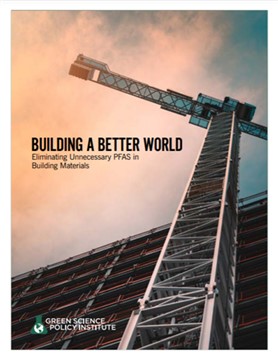May 2021 : Floor-to-Ceiling Forever Chemicals
In this edition:
- PFAS in Building Materials: Persistent and Pervasive
- Looking for Health Studies of PFAS? Look No More.
- Thousands of Industrial Chemicals Identified in Moms and their Babies
- Hormonally Active Dust
- CALENDAR
As colorful wildflowers bloom in the green hills of Berkeley, promising news regarding reducing harm from PFAS is contributing to feelings of spring optimism here at the Green Science Policy Institute.
At our Institute, we have been focused on reducing PFAS in food packaging, carpeting, furniture, and other products we bring into our homes, but it turns out our homes themselves are likely built with PFAS. We released a new report last month tracking down the use of these forever chemicals in a wide variety of building materials.
You can read more in the blurb below in Treehugger and Retrofit Magazine. If you’re in the building industry or would like to learn more about PFAS in the built environment, please do register for our May 13 webinar with internationally recognized environmental attorney Robert Bilott, our Senior Scientist Tom Bruton, and me.
In addition to pervading our built environments, forever chemicals have been found in some of the most pristine places in the world. I was interviewed by Climbing magazine about the accumulation of PFAS at camps on Mount Everest. PFAS-treated climbing gear— including tents, ropes, and clothing—are likely a major culprit. Our Institute is encouraging the outdoor industry to move away from forever chemicals. We hope to share some positive updates soon.
Stopping all nonessential uses of the entire class of PFAS—turning off the tap—is the key to curbing new indoor and outdoor PFAS pollution. “Things that are in our products don’t stay put,” notes our colleague and former NIEHS Director Linda Birnbaum in a recent article by Sharon Lerner about PFAS in dust. If PFAS get into our house dust, they can end up inside us and can interfere with the proper function of our hormones, as in the blurb below.
We commend companies that are voluntarily phasing out forever chemicals. For example, Keen is leading the way in the shoe industry. In a recent full-page ad in the New York Times, Keen shared their journey to PFAS-free so other companies could follow more quickly with less cost. You can find more PFAS-free brands on our list at PFAS Central.
Last week EPA AdministratorMichael Regan called for the creation of a new "EPA Council on PFAS" charged with better understanding and reducing the potential risks from these chemicals. EPA is acting to develop national drinking water regulations, collect new data on 29 PFAS in drinking water, and study PFAS in wastewater.
Also, I’m looking for a part-time personal/executive assistant for in-person work in North Berkeley. Excellent attention to detail, problem-solving, writing, research and computer skills, as well as a passion for reducing harm from toxic chemicals is required. To apply, please send a short cover letter including why you are interested in this position and your resume to [email protected]. Finally, for my August vacation, I’m planning a walking holiday in Iceland. Get in touch if you might like to join me.
Kind regards,
Arlene and the Green Science Policy team
PFAS in Building Materials: Persistent and Pervasive
by Tom Bruton
From the floor to the roof, the average building may be rife with PFAS—persistent and potentially toxic “forever chemicals”. Our new report documents that PFAS are used in a wide variety of building products. They are added to roofing materials, paints and coatings, sealants, caulks, adhesives, fabrics, glass, and more. PFAS provide functions such as weatherproofing, corrosion prevention, and resistance to stains, but their usefulness comes at a long-term cost to health and the environment.
Some of these building products can lead to increased PFAS levels in indoor dust and increased exposure for building occupants or maintenance workers. All building products made with PFAS contribute to pollution over their lifecycle—from PFAS production to product manufacturing to end-of-life disposal.
To move away from nonessential uses of PFAS, the building industry will need to embrace greater ingredient transparency and prioritize developing, specifying, and using products without PFAS. “Adding PFAS to building materials leads to pollution that will last decades, even centuries,” said David Johnson, AIA, a Principal at SERA Architects who reviewed the report. “Avoiding PFAS is a high-impact change the building industry can make now for healthier buildings and a healthier world.”
We invite you to join our webinar about this new report on May 13th at 10am Pacific / 1pm Eastern. Details and registration are here.
Looking for Health Studies of PFAS? Look No More.

By Carol Kwiatkowski
We know a lot about the chemical properties of PFAS. They don’t break down, they move around the planet, and they build up in the environment and people. But how much do we know about their toxicity, especially the many substitutes for well-studied PFOA and PFOS?
Manufacturers are quick to say their chemicals are safe, and others can similarly say “there’s not enough research.” Not satisfied with these responses, scientists from NRDC, the University of Texas and other institutions including me, set out to determine what was known about the less studied PFAS. Much to our surprise, we found over 740 studies on the health and toxicology of 29 PFAS other than PFOA and PFOS in humans, animals, and cells. We organized the research according to 15 health outcome categories and made the data easily accessible in our new PFAS-Tox Database. Please do take a look.
A quick view of the database reveals, for example, that over 400 studies analyzed PFNA, a chemical found in over 90% of Americans. Filters allow you to view only the studies on humans, or only early life exposure, or only studies without conflict of interest. A deeper dive is required to ascertain the results of each study, a task made easier by the posted abstract and a link to the original research. The database was received with enthusiasm by government and university scientists, non-profit organizations, and concerned citizens - all looking to better understand the toxicity of PFAS. Our blog tells more of the story.
Thousands of Industrial Chemicals Identified in Moms and their Babies
By Hannah Ray
In our modern world, we encounter a variety of synthetic chemicals every day— and many thousands show up in our blood. What types of chemicals make it inside us, and which are harmful? Answering this question is a huge challenge.
A recent study at UCSF screened for 3,500 industrial chemicals in blood samples collected from a diverse group of 30 mother/baby pairs in 2014 in San Francisco.
Over 1,400 suspect chemicals were found, and most were in both the maternal and the cord blood. They ranged from plasticizers, pharmaceuticals, and pesticides, to flame retardants and PFAS. Many of the chemicals did not have well-known uses, and 55 of them had not previously been reported in blood. These findings show the value of this screening strategy: it alerts scientists to unknown unknowns, which can then be assessed by biomonitoring, and it highlights the need for better tracking and regulation of the tens of thousands of chemicals in commerce in the U.S. Mothers should not need to fear passing these substances to their unborn children and babies should not be born pre-polluted.
Disclosure of what chemicals are in our everyday products and better regulation of the bad actors is urgently needed. You can learn more at www.SixClasses.org.
Hormonally Active Dust
By Anna Soehl
Even very small amounts of flame retardants and highly fluorinated chemicals (PFAS) used in everyday products and accumulating in our dust can interfere with the function of human sex hormones.
According to a new study in Environmental Health Perspectives, chemicals in indoor dust that contribute most to hormonal activity include:
- PBDEs or polybrominated diphenyl ethers: phased out toxic flame retardants still present in older furniture and electronics, as well as in products made of recycled materials
- OPEs or organophosphate esters: regrettable substitutes for organohalogen flame retardants
- PFAS: added to many products such as carpets, furniture, building materials, clothing, cookware, & food packaging
The good news is that our exposure to these chemicals can be curbed with the use of healthier materials. In North America, nearly all upholstered furniture is flame retardant-free. Many companies are also moving away from the use of PFAS and other toxics.
Our PFAS-free page and consumer-friendly tools such as Clearya can steer you towards healthier products.
We would also like to challenge the electronics, outdoor, and automotive industries to move away from PFAS and flame retardants. As long as such chemicals are added to products, our dust will continue to be hormonally active.
What can we do in the meantime? Avoid products that contain harmful chemicals and keep our hands and surfaces dust-free.
CALENDAR
May 13, 2021:
Webinar: Eliminating Unnecessary PFAS in Building Materials
10am Pacific
Noted attorney Rob Bilott and Tom Bruton and Arlene Blum from our Institute will share surprising new information on PFAS and its uses in the built environment--from roofing to paint to concrete sealers and more. We will give an overview of the findings in our upcoming report and propose a path forward to reducing PFAS usage for healthier buildings, people, and environment. All green builders, architects, and designers should consider attending. Space is limited. Register here.
May 25, 2021:
Columbia River Basin Restoration Working Group
1:50pm Pacific
During this forum on the Columbia River Basin Restoration Act implementation, toxics reduction, monitoring, research, and outreach, Arlene Blum will present The Chemical Class Approach for Healthier Products, People, & Environment.
More information: Mary Lou Soscia at [email protected]
Receive Updates By Email
Subscribe to our monthly newsletter and get these updates delivered right to your inbox!




